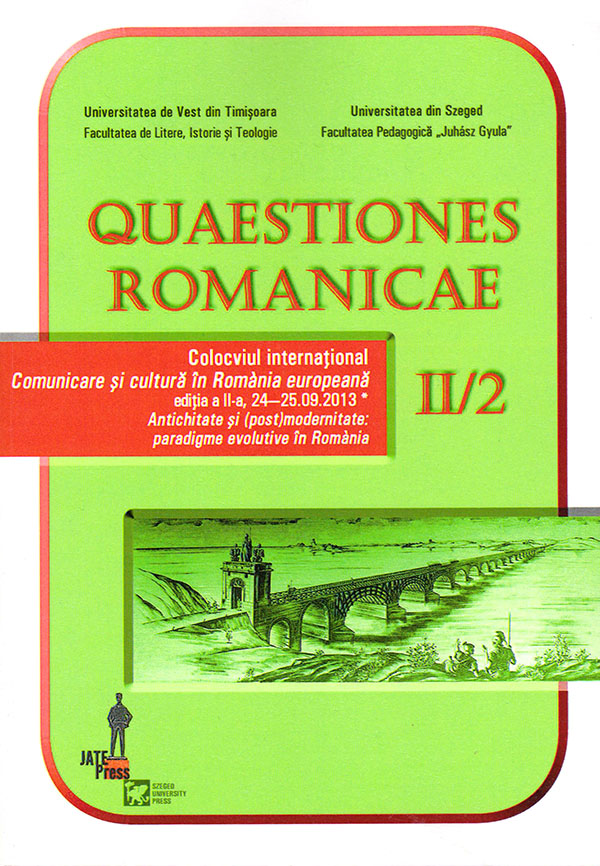Sigiliul Romei în România - Recompunerea oglinzii sparte a Crăiesei Zăpezii. Un studiu topografic într-o abordare multidisciplinară cu ecouri într-un hartă de navigaţie GPS a României
Abstract: (The Seal of Rome in Romania – Recomposing the Winter Queen’s broken mirror. A topographical study in a multidisciplinary approach with echoes in a GPS navigation map of Romania) The topographical positioning of the roman and roman-byzantine sites in Romania, member state of the European Union, was until recently a mere desiderate, inspite of large sums spent by the Ministry of Culture on projects of inventory and spatial positioning of sites classified as historical monuments. A novel, integrating approach, using GIS technologies, developed inside the Digital Romania Project, has taken into consideration most the information resources available in the archeological and historical literature as early as the XIX Century until nowadays regarding the positioning of all roman fortifications (citadelles, castrae, quadriburgiae, castellums, burgus, statio, towers and vallums) on the basis of which we built a database where we referenced the towns where such sites are present, the topographic names of the places, the site sources, their antique names, the situation plans, the detailed plans, the descriptions of their positioning (where situation plans were not available), the descriptions of their aspect (where no detailed plans were available), the bibliography yet to be reached by further research, images (historical photographs, pictures, engraved images and architectural reconstitutions) that would lead to a 3D digital reconstitution of the site together with their LMI (List of Historical Monuments) and RAN (National Archeological Repertoire) codes of the sites. Gradually this database came to include roman aqueducts and thermae, bridges, roads and settlements, villas, workshops and various other constructions. Although this would we classifieds as work in progress for the next 3 years, the results so far, materialized in the quarterly editions of the Digital Atlas of Romania, RO.A.D. are spectacular and destined to raise awareness for a larger audience.
Keywords: Roman Site, Localization, GPS Map, Romania.
Rezumat: Poziţionarea topografică a siturilor romane şi romano-bizantine din România, ţară membră a Uniunii Europene, a fost până de curând un obiectiv doar la stadiul de deziderat, în ciuda sumelor mari cheltuite în proiectele de inventariere şi poziţionare spaţială a siturilor monumente istorice de către Ministerul Culturii. O abordare nouă, integratoare, folosind tehnologii GIS, dezvoltată în cadrul Proiectului România Digitală, a luat în consideraţie majoritatea surselor de informaţie disponibile în literatura arheologică şi istorică din secolul XIX şi până în zilele noastre referitoare la poziţionarea fortificaţiilor romane (cetăţi, castre, quadriburgium-uri, castellum-uri, burgus-uri, statio, turnuri şi vallum-uri) pe baza cărora a construit o bază de date în care s-au referenţiat localităţile în care sunt prezente situri, denumirile toponimelor, sursele de situri, denumirile antice ale acestora, planurile de situaţie ale acestora, planurile lor de detaliu, descrierile poziţionărilor (acolo unde nu existau planuri de situaţie), descrierile aspectului fortificaţiilor (acolo unde nu existau planuri de detaliu), bibliografia lucrărilor de interes pentru sit la care nu s-a ajuns încă să fie consultate la momentul înregistrării, vederi (istorice, fotografii, gravuri şi reconstituiri) care pot duce la reconstituirea 3D a obiectivelor în discuţie precum şi codurile LMI (Lista Monumentelor Istorice) şi RAN (Repertoriul Arheologic Naţional) ale siturilor în cauză. Treptat, baza de date a ajuns să includă apeductele şi termele, podurile, drumurile şi localităţile romane, vilele, varii construcţii şi ateliere romane. Deşi este la stadiul de proiect în desfăşurare pentru cel puţin încă trei ani, rezultatele de până acum - concretizate în ediţiile trimestriale ale Atlasul Digital al României, RO.A.D. - sunt spectaculoase şi destinate unui public larg.
Cuvinte cheie: Poziţionare, Situri Romane, Hartă GPS, România.
